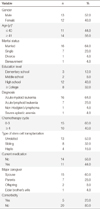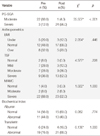Abstract
Purpose
This study was performed to identify the pre-and post-transplant nutritional assessment for patients undergoing allogeneic hematopoietic stem cell transplantation (HSCT).
Methods
The subjects of this study were 25 patients undergoing allogeneic HSCT. The data collection was performed from January 31st to March 31st, 2011. The Patient-Generated Subjective Global Assessment (PG-SGA), anthropometrics and biochemical test were collected from the time they entered the isolation unit until they left.
Results
Pre-transplant nutritional assessment status indicated moderate malnutrition which scored 7.32±1.68 in PG-SGA. There were 22 patients (88.0%) with moderate malnutrition and 3 patients (12.0%) with severe malnutrition. Post-transplant nutritional assessment indicated severe malnutrition status which scored 11.92±3.26 in PG-SGA. Pre-and post-transplant nutritional assessment displayed significant differences (p<.001) in PG-SGA score. Hematopoietic stem cell transplantation led to a deterioration of patients' nutritional status. Pre-transplant patients were already in malnutrition status and patients undergoing allogeneic HSCT were at risk for malnutrition.
Conclusion
Pre- and post-transplant patients were categorized as having undernutritional and malnutritional status. Pre-transplant nutrition status impacted on post-transplant nutritional status. Health care personnel should pay attention to patient's nutrition status when undergoing allogeneic HSCT with appropriate nutritional assessment tools.
Figures and Tables
Table 2
Pre-transplant nutritional assessment using PG-SGA, anthropometrics, biochemical indices (N=25)

References
1. Kang YA, Lee MS. Ethnography on isolation unit for hematopoietic stem cell transplantation. J Korean Oncol Nurs. 2009. 9:31–42.
2. Bensiner WI, Martin PJ, Storer B, Clift R, Forman SJ, Negrin R, et al. Transplantation of bone marrow as compared with peripheral-blood cells from HLA-identical relatives in patients with hematologic cancers. NEJM. 2001. 344:175–181.

3. Yang YH, Kwon SJ, Kim CI. The nutritional status of the patients with cancer during the chemotherapies. J Korean Acad Nurs. 2001. 31:978–987.

4. Dreizen S, McCredie KB, Keating MJ, Andersson BS. Nutritional deficiencies in patients receiving cancer chemotherapy. Postgrad Med. 1990. 87:163–167.

5. Min HS, Hwang WH. The effects of nutritional education program on nausea and vomiting, anorexia, food intake, and nutritional status of GI cancer patients undergoing chemotherapy. J Korean Oncol Nurs. 2010. 10:38–47.
6. Martin-Salces M, Raquel DP, Miguel AC, Alfonso M, Fernando HN. Nutritional recommendations in hematopoietic stem cell transplantation. Nutrition. 2008. 24:769–775.

7. So EJ, Kim JY, Jung SJ, Park S. Analysis of the factor relating nutritional status in discharging of leukemia patients receiving chemotherapy. Korean J Nutr. 2010. 43:26–33.

8. Middleton MH, Nazarenko G, Nivison-Smith I, Smerdely P. Prevalence of malnutrition and 12-month incidence of mortality in two Sydney teaching hospitals. Intern Med J. 2001. 31:455–461.

9. So HS. Assessment of appetite and nutritional status in cancer patients undergoing radiation therapy: A prospective study. J Korean Acad Nurs. 1999. 29:1179–1191.

10. Barrera R. Nutrition support in cancer patients. JPEN J Parenter Enteral Nutr. 2002. 26:63–71.
11. Kim HM. Management of chemotherapy-related toxicity: Nutrition support during chemotherapy. Korean Soc Clin Oncol. 2005. 4:23–33.
12. Bechard LJ, Guinan EC, Feldman HA, Tang V, Duggan C. Prognostic factors in the resumption of oral dietary intake after allogeneic hematopoietic stem cell transplantation (HSCT) in children. JPEN J Parenter Enteral Nutr. 2007. 31:295–301.

13. Wedrychowicz A, Spodaryk M, Krasowska A, Gozdzik J. Total parenteral nutrition in children and adolescents treated with high-dose chemotherapy followed by autologous haematopoietic transplants. Br J Nutr. 2010. 103:899–906.

14. Forchielli ML, Azzi N, Cadranel S, Paolucci G. Total parenteral nutrition in bone marrow transplant: What is the appropriate energy level? Oncology. 2003. 64:7–13.

15. Muscaritoli M, Gabriella G, Saveria C, Anna PI, Fillippo RF. Nutritional metabolic support in patients undergoing bone marow transplantation. Am J Clin Nutr. 2002. 75:183–190.

16. Rzepecki P, Barzal J, Sarosiek T, Szczylik C. Biochemical indices for the assessment of nutritional status during hematopoietic stem cell transplantation: are they worth using? A single center experience. Bone Marrow Transplant. 2007. 40:567–572.

17. Bae JH, Kim SK. The effect of total parenteral nutrition on hospitalized patients according to nutritional status. Korean J Community Nutr. 2003. 8:574–583.
18. Takatsuka H, Takemoth Y, Iwata N, Suehiro A, Hamano T, Okamoto T, et al. Oral eicosapentaenoic acid for complications of bone marrow transplantation. Bone Marrow Transplant. 2001. 28:769–774.

19. Arfons LM, Lazarus HM. Total parenteral nutrition and hematopoietic stem cell transplantation. Bone Marrow Transplant. 2005. 36:281–288.

20. Lynne D. Good nutrition for good surgery: clinical and quality of life outcomes. Australian Prescriber. 2003. 26:136–140.

21. Yang YH, Choi SM, Kim EK. Changes in nutritional status of general medical patients during hospitalization. J Nurs Acad Soc. 1997. 27:49–60.

22. Hadjibabaie M, Iravani M, Taghizadeh M, Ataie-Jafari A, Shamshiri SA, Mousavi SA, et al. Evaluation of nutritional status in patients undergoing hematopoietic SCT. Bone Marrow Transplant. 2008. 42:469–473.

23. Ottery FD. Definition of standardized nutritional assessment and interventional pathways in oncology. Nutrition. 1996. 12:S15–S19.

24. Curtas S, Champman G, Meguid MM. Evaluation of nutritional status. Nurs Clin North Am. 1989. 24:301–313.
25. Frisancho AR. New norms of upper limb fat and muscle areas for assessment of nutritional status. Am J Clin Nutr. 1981. 34:2540–2545.

26. Donoghue M, Nunnally C, Yasko JM. Nutritional needs of cancer patients. Nurs Clin North Am. 1982. 16:295–302.
27. Park HJ. Nutritional Assessment for hemopoietic stem cell transplantation patients [dissertation]. 2000. Seoul: Catholic Univ..
28. Kuszajewski ML, Kuszajewski LM. Prealbumin is best for nutritional monitoring in hospital. Nursing. 2005. 35:70–71.




 PDF
PDF ePub
ePub Citation
Citation Print
Print





 XML Download
XML Download